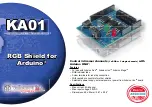
MS51
Dec. 17, 2019
Page
255
of 316
Rev 1.01
M
S51
SE
RIES
TE
CHNICA
L REF
ERE
N
CE MA
NU
A
L
6.9
Serial Peripheral Interface (SPI)
The MS51 provides two Serial Peripheral Interface (SPI) block to support high-speed serial
communication. SPI is a full-duplex, high-speed, synchronous communication bus between
microcontrollers or other peripheral devices such as serial EEPROM, LCD driver, or D/A converter. It
provides either Master or Slave mode, high-speed rate up to
F
SYS
/4
, transfer complete and write
collision flag. For a multi-master system, SPI supports Master Mode Fault to protect a multi-master
conflict.
Divider
/2, /4, /8, /16
Select
MSB
LSB
P
in
C
o
n
to
rl
L
o
g
ic
MISO
MOSI
SPCLK
SS
SPI Status Control Logic
SPI Status Register
SPI Control Register
Clock Logic
S
M
M
S
CLOCK
S
P
IF
W
C
O
L
S
P
IO
V
F
M
O
D
F
D
IS
M
O
D
F
SPI Interrupt
S
P
IE
N
MSTR
M
S
T
R
S
S
O
E
D
IS
M
O
D
F
S
P
R
0
S
P
R
1
S
P
R
0
S
P
R
1
C
P
H
A
C
P
O
L
M
S
T
R
L
S
B
F
E
S
P
IE
N
S
S
O
E
SPIEN
Internal
Data Bus
F
SYS
Write Data Buffer
8-bit Shift Register
Read Data Buffer
Figure 6.9-1 SPI Block Diagram
Figure15.1 SPI Block Diagram shows SPI block diagram. It provides an overview of SPI architecture in
this device. The main blocks of SPI are the SPI control register logic, SPI status logic, clock rate
control logic, and pin control logic. For a serial data transfer or receiving, The SPI block exists a write
data buffer, a shift out register and a read data buffer. It is double buffered in the receiving and
transmit directions. Transmit data can be written to the shifter until when the previous transfer is not
complete. Receiving logic consists of parallel read data buffer so the shift register is free to accept a
second data, as the first received data will be transferred to the read data buffer.
The four pins of SPI interface are Master-In/Slave-Out (MISO), Master-Out/Slave-In (MOSI), Shift
Clock (SPCLK), and Slave Select (
SS
̅̅̅̅
). The MOSI pin is used to transfer a 8-bit data in series from the
Master to the Slave. Therefore, MOSI is an output pin for Master device and an input for Slave.
Respectively, the MISO is used to receive a serial data from the Slave to the Master.
The SPCLK pin is the clock output in Master mode, but is the clock input in Slave mode. The shift
















































